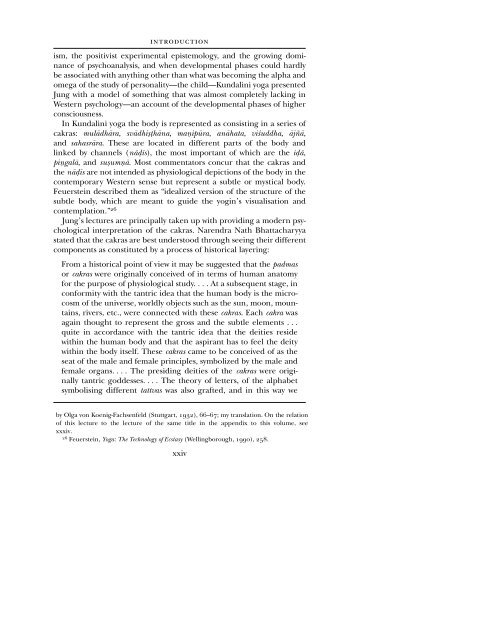CG JUNG - Countryside Anarchist
CG JUNG - Countryside Anarchist
CG JUNG - Countryside Anarchist
Create successful ePaper yourself
Turn your PDF publications into a flip-book with our unique Google optimized e-Paper software.
INTRODUCTION<br />
ism, the positivist experimental epistemology, and the growing dominance<br />
of psychoanalysis, and when developmental phases could hardly<br />
be associated with anything other than what was becoming the alpha and<br />
omega of the study of personality—the child—Kundalini yoga presented<br />
Jung with a model of something that was almost completely lacking in<br />
Western psychology—an account of the developmental phases of higher<br />
consciousness.<br />
In Kundalini yoga the body is represented as consisting in a series of<br />
cakras: mulvdhvra, svvdhiü°hvna, maõipÖra, anvhata, viçuddha, vjñv,<br />
and sahasrvra. These are located in different parts of the body and<br />
linked by channels (nvìzs), the most important of which are the iìv,<br />
piõgalv, andsuüumõv. Most commentators concur that the cakras and<br />
the nvìzs are not intended as physiological depictions of the body in the<br />
contemporary Western sense but represent a subtle or mystical body.<br />
Feuerstein described them as “idealized version of the structure of the<br />
subtle body, which are meant to guide the yogin’s visualisation and<br />
contemplation.” 26<br />
Jung’s lectures are principally taken up with providing a modern psychological<br />
interpretation of the cakras. Narendra Nath Bhattacharyya<br />
stated that the cakras are best understood through seeing their different<br />
components as constituted by a process of historical layering:<br />
From a historical point of view it may be suggested that the padmas<br />
or cakras were originally conceived of in terms of human anatomy<br />
for the purpose of physiological study. . . . At a subsequent stage, in<br />
conformity with the tantric idea that the human body is the microcosm<br />
of the universe, worldly objects such as the sun, moon, mountains,<br />
rivers, etc., were connected with these cakras. Each cakra was<br />
again thought to represent the gross and the subtle elements . . .<br />
quite in accordance with the tantric idea that the deities reside<br />
within the human body and that the aspirant has to feel the deity<br />
within the body itself. These cakras came to be conceived of as the<br />
seat of the male and female principles, symbolized by the male and<br />
female organs. . . . The presiding deities of the cakras were originally<br />
tantric goddesses. . . . The theory of letters, of the alphabet<br />
symbolising different tattvas was also grafted, and in this way we<br />
by Olga von Koenig-Fachsenfeld (Stuttgart, 1932), 66–67; my translation. On the relation<br />
of this lecture to the lecture of the same title in the appendix to this volume, see<br />
xxxiv.<br />
26 Feuerstein, Yoga: The Technology of Ecstasy (Wellingborough, 1990), 258.<br />
xxiv


